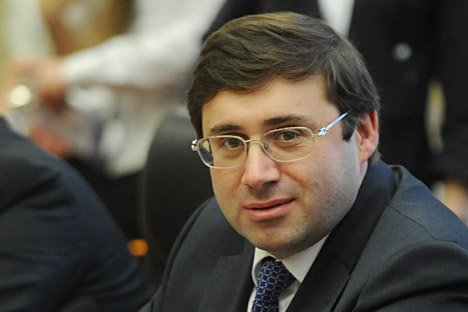
First deputy chairman Sergei Shvetsov was appointed to head a new Russian financial market mega regulator. Source: ITAR-TASS
On Sept. 1, the Central Bank of the Russian Federation became the entire country’s financial market regulator, due to the transfer of a number of functions previously performed by the Federal Financial Markets Service (FFMS).
In addition to its supervision of commercial banks, the function of a single regulator includes monitoring non-bank financial institutions such as insurance companies, asset management companies, pension funds, brokers and exchange intermediaries, as well as microfinance institutions.
The new agency is headed by First Deputy Chairman Sergei Shvetsov — the ideologist behind the creation of a dual currency basket floating corridor, which was launched in 2009. According to him, the changes that accompany the transfer of the Central Bank’s functions will not be dramatic and will be quite slow. The main thing is the synergy effect from the merger of the two structures.
The idea of creating a financial mega regulator in Russia had been discussed for the last seven years. It had opponents, who believed it was unnecessary to create a single agency and that the powers of existing regulators should be defined better by changing the legislation.
Meanwhile, the mega-organization’s supporters had disagreements arise while deciding which agency the creation a chief overseer should be based on. First to be discussed was the option of creating it on the basis of FFMS, which already controls the stock and insurance markets. Then the option of creating the mega regulator based on the Central Bank — which has accumulated a lot of experience supervising banks — outweighed the previous one.
As a result, in December 2012, the government decided to integrate the FFMS into the Central Bank, allocating between 18 months and two years to the amalgamation process.
In general, experts positively estimate the appearance of a single supervisory body. According to the chief economist of Deutsche Bank Russia, Yaroslav Lisovolik, the establishment of a mega regulator is a positive factor for the Russian economy; it fits into the general trend of regulatory changes of the leading financial markets. For example, the European Central Bank is gradually gaining more and more power.
"With the conditions whereby various segments of the market are interconnected, consistency and prompt action are important to resolve a crisis. We have segments of the market that require active policy decided by a regulator," said Lisovolik.
In his opinion, the FFMS did not have enough opportunities to solve all the problems in areas it holds accountable. As for the stock market, according to Lisovolik, its response is generally restrained.
"Some investors fear that the Central Bank will be less focused on a flexible exchange rate and inflation targeting,” the expert said. For foreign investors, the pros and cons of creating a mega regulator will become apparent only after some time.
Foreign banks may contribute to Russia's economy
Central Bank worried about consumer debt
Russia passes money-laundering law
Financial discipline may slip as Russians use more credit cards
For now, foreign investors, like the Russian participants in the market, are hoping that the Central Bank as a mega regulator can solve some of the issues on reform harmonization faster. According to Lisovolik, due to several decision-making centers, some reforms (such as the introduction of Euroclear calculations) were previously moving too slowly.
“In my opinion, the introduction of a mega regulator will have a positive impact on the financial markets. Previously, the Central Bank of the Russian Federation had built a regulatory system for banks, which includes, inter alia, control of economic indicators to give a timely response to the worsening of the financial situation of credit institutions.
Requirements for banks’ capital were also developed. Rather, a system of indicators will not damage the rest of the market players, either, including microfinance institutions, and it will make the business more transparent," said Elena Bukina, head of Absolut Bank’s internal control.
According to her, "the creation of a mega regulation institution can minimize systemic risk, improve the protection level of investors and depositors," which is likely to have a positive impact on the Russian economy. Bukina believes the creation of a mega regulator will promote the growth of Russia’s investment attractiveness, as it will increase business transparency and predictability.
According to Geoffrey Nicholson, a partner at PricewaterhouseCoopers Russia, the country is following the path of many developed countries that have united their regulators to avoid some of the problems associated with insufficient and fragmentary regulation, which existed before the 2008 crisis.
"For foreign investors, it will be a signal similar to the adoption of IFRS and the accession to the WTO and the Basel agreement — that Russia wants to be a full and modern member of the world financial and commercial economy," said the expert.
According to the managing partner of Third Rome, Andrei Movchan, the creation of a single regulator fully fits into an actively implementable idea of the power vertical. The advantages of multiple regulators, according to him, consist in each one them having its own policies and its own initiatives.
"For example, the U.S. Federal Reserve System is a canvas mosaic; each bank has its own policy," said Movchan. In Russia, however, even when there are multiple regulators, they have no independence, so their existence does not give any advantages to the financial markets.
Therefore, for Russia, according to Movchan, the amalgamation of regulators is rather an advantage, since it is easier to manage a single organization and it costs less.
All rights reserved by Rossiyskaya Gazeta.
Subscribe
to our newsletter!
Get the week's best stories straight to your inbox